Highly compact nanochannel thin films with exceptional thermal conductivity and water pumping for efficient solar steam generation†
Abstract
Synergetically integrating multiple capabilities into a nanostructured material has become one kind of reliable and sustainable strategy for resolving tricky issues in the energy and environmental fields. Herein, we prepare a series of nanochannel thin films by simply assembling cellulose nanofibers with reduced graphene oxide, dominantly driven by van der Waals interactions. The thicknesses of the as-prepared thin films can be well controlled within several micrometers. Their highly compact nanochannel structures were evidenced by the densities of up to 1.1 g cm−3 and the largest Brunauer–Emmett–Teller specific area of 126 m2 g−1, endowing them with excellent hygroscopicities (282 mg g−1) and exceptional in-plane thermal conductivities (614–1238 W m−1 K−1 at 25–80 °C), among the highest values for carbon-based composites. Such thin-film composites are readily used for solar-steam generators, delivering an evaporation rate of 1.47 kg m−2 h−1 under 1 sun illumination, and are also easy to integrate into a high-performance amplified system for desalination on a large scale under natural solar irradiation.



 Please wait while we load your content...
Please wait while we load your content...